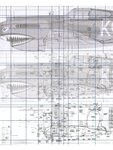(Off topic for a second): Phantoms in SE Asia used to experience a phenomenon called "mach bite", where the honeycomb filled entire outer wing panel aft of the leading edge/spar D tube would get saturated with moisture during the monsoon season and freeze at altitude, bulging the skin outward. If the plane then flew fast enough to generate a shock wave, the entire panel aft of the spar would pop right out leaving the spar and D tube giving the proverbial "one finger salute". This didn't constitute much of an emergency, as there were no flight controls or plumbing out there, just an extra 15 knots on final, bingo ashore if carrier based, and take the wire on landing. We had one come in at Boca Chica after a midair collision that took off the entire panel, and it was a nugget pilot at the controls with a 2 'Nam tour RIO in the back seat practicing his oratory skills. Piece of cake. The plane was fixed in time to fly the last cycle of the day.People tend to think that the tropics are hot and therefore icing will not be a problem. The reality is that the very high humidity means that icing is a serious problem and extends far higher than in temperate and cold weather climates.
Cheers,
Wes

